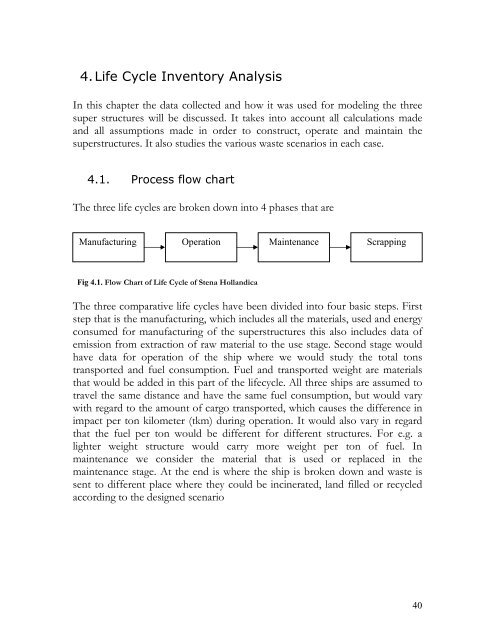Life Cycle Assessment of Fiber Composites_final__rättad
Life Cycle Assessment of Fiber Composites_final__rättad
Life Cycle Assessment of Fiber Composites_final__rättad
You also want an ePaper? Increase the reach of your titles
YUMPU automatically turns print PDFs into web optimized ePapers that Google loves.
4. <strong>Life</strong> <strong>Cycle</strong> Inventory Analysis<br />
In this chapter the data collected and how it was used for modeling the three<br />
super structures will be discussed. It takes into account all calculations made<br />
and all assumptions made in order to construct, operate and maintain the<br />
superstructures. It also studies the various waste scenarios in each case.<br />
4.1. Process flow chart<br />
The three life cycles are broken down into 4 phases that are<br />
Manufacturing Operation Maintenance Scrapping<br />
Fig 4.1. Flow Chart <strong>of</strong> <strong>Life</strong> <strong>Cycle</strong> <strong>of</strong> Stena Hollandica<br />
The three comparative life cycles have been divided into four basic steps. First<br />
step that is the manufacturing, which includes all the materials, used and energy<br />
consumed for manufacturing <strong>of</strong> the superstructures this also includes data <strong>of</strong><br />
emission from extraction <strong>of</strong> raw material to the use stage. Second stage would<br />
have data for operation <strong>of</strong> the ship where we would study the total tons<br />
transported and fuel consumption. Fuel and transported weight are materials<br />
that would be added in this part <strong>of</strong> the lifecycle. All three ships are assumed to<br />
travel the same distance and have the same fuel consumption, but would vary<br />
with regard to the amount <strong>of</strong> cargo transported, which causes the difference in<br />
impact per ton kilometer (tkm) during operation. It would also vary in regard<br />
that the fuel per ton would be different for different structures. For e.g. a<br />
lighter weight structure would carry more weight per ton <strong>of</strong> fuel. In<br />
maintenance we consider the material that is used or replaced in the<br />
maintenance stage. At the end is where the ship is broken down and waste is<br />
sent to different place where they could be incinerated, land filled or recycled<br />
according to the designed scenario<br />
40
















